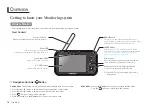
Page
12
5.
Balance
:
This
controls left/right levels for the stereo mixes. By default, it controls
loudspeaker and headphone output. As you rotate the knob, the Monitor Info box at
the top center of the screen temporarily changes to an indicator of the Balance
setting:
6.
Adjust A Knob
: This control can be rotated to move the orange Loudness
Selection bracket from channel cluster to channel cluster. The Loudness indication
then displays the loudness of the selected cluster. Pressing the
Adjust A
knob
causes the Monitor Info display to show either the selected input source or the
video mode of the incoming signal. It can also have other purposes, depending
upon the needs of various screens and menus.
7.
Adjust B Knob
: Turning this control right or left moves a white selection box from
channel to channel on the metering screen. Pressing the
Adjust B
control solos the
selected channel. If a muted channel is selected with this control, it is unmuted and
soloed. Pressing the
Adjust B
control again or touching the meter area anywhere
removes the channel solo. On units equipped with the Dolby Decode option, if the
Adjust B
control is used to select a Dolby stream and then pressed, the Dolby
Zoom feature will activate and display the channels within the Dolby signal, as well
as Dolby MetaData.
8.
USB 2.0 Port
: This USB Type A connector allows you to use a flash drive (not
supplied) to perform software updates and copy system configurations to another
iAM-12G-SDI or to a PC. Software updates are accomplished from the Web GUI.
9.
Level Meters
: High resolution bar graph meters appear here showing the levels of
up to 16 channels selected for monitoring. These can be grouped into clusters as
specified in the Web GUI: mono clusters (1.0), pair clusters (2.0), or surround
sound clusters. This screen will respond to touch control of audio Mute, Unmute and
Solo. Access to the Menu screens is also available on this screen. The meter display
is temporarily replaced when menu access is needed. These menus are used for
setup and status display.
10.
Phase Indicators
: There is one Phase Indicator per channel pair. It is dark green
when the channels are in phase and bright red when they are out of phase. Using
the
Configuration | System Preference | Phase Indicator Configuration
tab
in the Web GUI, you may determine which channel pairs should have a Phase
Indicator and which shouldn't, for example, because they contain unrelated signals.
11.
Loudness
: The Loudness of the selected channel cluster is displayed here. Use the
Adjust A knob to select the channel cluster to be monitored.
12.
Monitor Info
: Generally, the name of the current Input Source is displayed here.
The
SDI signal format, HDR detection,
or other channel setup information may
alternatively be displayed by pressing the
Adjust A
knob.
13.
Menu
: Touch to reveal the Menu. Refer to the
Menu / Option Touchscreen
section of this chapter.
14.
Power
: This indicator lights green when the system is powered and ready for use.
A solid or blinking red or yellow color indicates that the product is starting up.
Summary of Contents for iAM-12G-SDI
Page 6: ...Page 6 APPENDIX E API Documentation 139 Introduction 139 API Presets 139...
Page 92: ...Page 92 Figure 4 21 Remote Monitor ED2 Single Presentation...
Page 94: ...Page 94 Figure 4 23 Remote Monitor Dolby E DE...
Page 95: ...Page 95 Figure 4 24 Remote Monitor DD with ATMOS...
Page 98: ...Page 98 Figure 4 27 System Setup SFP Information...
Page 151: ...Page 151 channel_number 1...













































